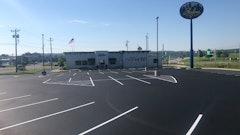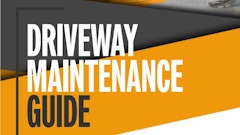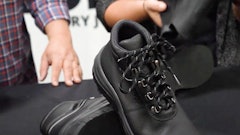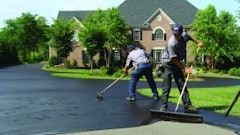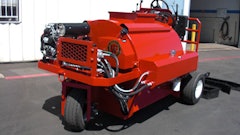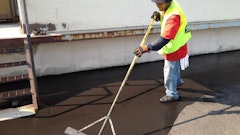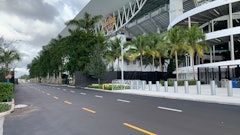
Customers are not just comparing prices, they?re comparing contractors and I think sometimes we forget that," says Steve Young, owner and president of Young Sealcoating, Lynchburg, VA. "You have to sell yourself."
So in addition to focusing on providing the quality, detailed work Young Sealcoating is known for, Young works hard to present his company to the market not only as a professional business but as a large business that operates much the way a larger business might operate. And that's despite the fact that Young Sealcoating employs only eight people in peak season and runs only a single sealcoating crew.
"We want to appear large and we want to operate like a larger business would because that gives us access to more jobs and also makes our customers feel more comfortable doing business with us," Young says. "It also helps differentiate us from the competition."
And it's not just about appearing larger. "It's about establishing our credibility as a competent and professional contractor," he says.
"Price conscious" to "professional"
Like many start-up contractors, Young's biggest concern in the early 1990s was getting enough work to survive. So he was very price conscious, worried that he might price himself out of a job. But he decided, eventually, that wasn't the way to grow his business. He bought his first sealcoating tank, used, from Neal Manufacturing and from them learned about National Pavement Expo (NPE). "I thought I could probably learn something there so went and gave it a try," he says. "I've been back every other year since."
He says that in addition to getting technical crack repair training at his first NPE, the most important thing he learned was about the industry.
"I had this impression that this industry wasn't looked at as professional, and was I ever wrong," Young says. "It was nice to see thousands of people who considered themselves business people, who talked like professionals, and who obviously worked to develop their business - just like I do."
He says "it's not just going to seminars" where he found professionalism. "It's talking to people on the floor, talking to people in the hallways, paying attention at the Roundtables," he says. "I'm always asking 'What have you done that makes you successful'" and while some people don't want to talk about it or don't have a specific answer, many people do because they are proud of what they've accomplished, and they're willing to share."
And this year Young is one of the new NPE speakers, presenting "Seal the Deal: How Your Image and Presentation Can Make You or Break You" on Feb. 2 in Nashville.
Focus on sealcoating
Young started in business in 1990, working from a Honda hatchback, sweeping driveways by hand, and applying sealer by the bucket. Today, Young Sealcoating Inc. (incorporated in 1995) operates five trucks, including three dump trucks, a pickup, and a Suburban SUV. One truck hauls the 750-gal. Seal-Rite sealcoating tank while the three dump trucks handle remove-and-replace repairs and hot pour cracksealing.
Young generates 60% of sales from commercial work and 40% of sales from residential work, though he does more driveways than parking lots. He says most driveways range from 3,500 to 4,000 square feet, and Young Sealcoating completes two or often three a day, all by hand because he says the finish looks better.
Young says 80% of sales result from hot pour cracksealing and sealcoating (Young Sealcoating works its way through 4,000-gallons of Gem Seal sealer every three weeks) and 20% of sales are from asphalt cut-and -patch repairs. The company subcontracts out striping, paving, and large-scale repair work.
"I'm a firm believer in focusing on what we do well, and what we do well is sealcoating," he says. "We don't chase a lot of cut and patch, but we do pursue a lot of sealcoating. We do small-scale cut-outs, 18 ft. by 12 ft, is about average for us, and most of the time I do cut and patch because it's got to get done before I sealcoat the lot."
Insurance differentiates
One of the most innovative steps Young Sealcoating has taken to "work larger" is to buy an insurance policy unusually large for a company of its size. The large policy enables Young to bid jobs many small contractors can't pursue, then operate as a general contractor on the projects to sub out paving, striping, power washing, and sweeping while reserving the sealcoating or repair work for itself.
Young says that when he gets the bid packet he makes sure to read the insurance requirements because if they're high there will be fewer bidders for the job. Plus, the customer will pay more for the work because the insurance requirement is high. He says his insurance premiums are not cheap, but the costs are built into the bids and the cost is offset by the ability to work on larger jobs for larger companies.
"Most people have the mentality 'let me have the smallest amount of insurance to get by.' We went the opposite direction. We decided 'Let's get the most insurance we can get' and we did," he says. "That enables us to bid larger contracts that we couldn't otherwise bid and that our competition can't bid."
He says that even just for striping work for some large jobs the customer wants the striper to carry a tremendous amount of insurance. "Most stripers don't but we do so we can bid and get the job, then sub the work out to the stripers we know who do it the right way," he says.
He says having this amount of insurance turned a recent $38,000 contract into an $110,000 contract and turned a $2,800 contract into a $7,500 contract.
"But the ticket to getting the contract is having that policy," Young says. "There's no question this helps us look like a bigger contractor, but even more important is the fact that because we have it we can operate in the market the same way a bigger company would operate."
Marketing
Young recognizes that a company's marketing efforts have a huge impact on how it is perceived in the market, and he takes a unique approach to marketing: Young Sealcoating makes no cold calls and does no direct-mail marketing.
"I'm a strong supporter of direct mail, but we don't need it at this point," he says. "We did use it for a while, but now we're established enough so we don't need to have that." He annually runs a full-page ad inside the front cover of a local magazine that's delivered to every home in the area, but that and a Yellow Pages ad are the extent of his print marketing. Yet Young Sealcoating receives as much as 10 to 15 calls for bids daily during peak season.
"Of those 15 there might be seven or eight we're interested in bidding, and we might get six of those to bid," he says. "I would expect to get four or five of those six to work on."
And his marketing tool with the biggest impact? Signs at the jobsite. The signs, about the same size as real estate signs, cost about $4 each and are disposable.
"The signs are our biggest and most-effective advertising," he says. "We put them up when we start the job and we leave them up when we're finished."
And the signs often remain up long after the job is done.
"We try to pick them up when we're back in an area, but we don't always get back to them. So on the bottom of each sign is printed 'please dispose of or recycle,' so if we don't get back the customer knows he can just throw it away himself," he says. "They end up staying up pretty long, and we get a lot of referrals from them."
He says that on any given day Young Sealcoating might have 30 signs out all over town. "So the impression is we're everywhere. Even though we just do one job at a time, with the signs out there we seem larger than we really are, and we seem like we're all over."
The signs lead to Young Sealcoating's second most-effective marketing tool, referrals. Even other sealcoating contractors refer work to Young. "One job was way too big for one of our competitors so he told the customer to call us." Another job on a long driveway at a large house had a lot of detail work in it and after the conversation with the owner it kind of freaked the contractor out. He was worried he couldn't handle the job so he called us.
"We get at least one referral a day," he says. "The paving company we sub work to refers work to us, former customers, non-customers who see our work, realtors, and residences refer to us."
And that's not an accident. Young says he pursues referrals, encouraging customers to pass the Young Sealcoating name along.
"When any customer signs the contract and chooses us to do the work we let him know we're committed and then we ask him to pass our name along to friends if he's happy with us," he says. "It's not unusual on commercial work to hear we've been recommended."
No answering machine
Young says the first effort to appear larger starts with a customer's first contact with the company, the incoming phone call. He says he realized early on that large companies, whether they're contractors or not, handle incoming calls in a certain way, and he set up Young Sealcoating to operate the same way.
"When people contact us they hear a real voice, not an answering machine," he says. "When you have an answering machine you leave the impression that you're small. A larger company usually has someone answering the phone. We look like a bigger company because there's no answering machine."
But rather than hiring a secretary or office manager to field calls, Young Sealcoating hires an answering service. "That gives callers the image of someone there, that there's always someone answering the phone so they feel they can always reach someone."
And that's just the first step. Young Sealcoating uses the calls as a larger company would, getting information from them that would not be obtained through an answering machine.
"We use the answering service to get as much information from the customer as we can. We want to know how they found out about us, and this is how we know that our signs are so effective and that our referrals are so strong," he says.
When Young follows up on the contact, they ask about the nature of the job, the size, and as many other details as they can. Then, based on that information, Young is able to prioritize the work before he schedules appointments for estimates.
"And I always try to return calls, whether I think I'm going to pursue the job or not. We try to never let them go without a response," he says.
All this information is also entered into the computer by the answering service for a complete record of all calls.
The sales call impression
Because he's trying to create an image and avoid price-based work Young tries to meet with all customers. "We're aiming higher than just leaving a price. We're out there to let them know who we are and what we can do," Young says. "When we meet, I try to talk with them a little, be genuine with them, especially residential, because it will help them remember me."
Meeting with customers also enables Young to reinforce the big-company image he wants to project.
"We try to work any large parking lot we've done recently into the conversation. "Did you call us because of work we're doing at X place'" "Did you see our work over at X place" If they say 'Yes,' good. If they say 'No,' that let's them know the size and type of work we're doing and capable of. The point is to establish credibility."
Young reinforces that largeness by referring to himself as the project manager. "When I say 'project manager' it let's them know I'm the guy in charge of this project," Young says. "If they ask for the president I never lie, I tell them it's me. I never misrepresent myself or my company. But saying I'm the project manager makes us look larger."
Young says that when approaching the sales call he approaches it assuming Young Sealcoating already has the job and spends the time with customer educating him and trying to get a positive response, a 'yes.' But he says it's important to remember that an objection is not a 'no.'
"If I can't close the sale that gives me the opportunity to ask 'Is there anything I shared with you that has not convinced you to use us as your contractor'" Often I can find out what the concern is - and most often it's price - and then I can deal with that and bring the discussion back to value and go over the breakdown of the bid," Young says.
And if Young doesn't get that final 'yes,' he leaves behind a brightly colored sheet that lists "10 Things To Ask Your Pavement Maintenance Contractor," including such questions as are they licensed? Will they repair the cracks properly? How will they apply the sealer?
"It helps them compare apples to apples, and it helps say 'Hey, these guys are sharp'," Young says.
The proposal
An integral aspect of each sales call is Young Sealcoating's proposal, which is designed to portray a large company with detail and professionalism. Young says each proposal is itemized, with each aspect of the job priced out.
"We go into a lot of detail on our bids, and we try to educate the customer," Young says. "We tell them we're not trying to be the lowest bidder just to get the job but that we want to do the best job and provide exactly the work their pavement requires.
"It's a great way to separate yourself from the competition because by itemizing your work on the bid you are showing them all the things you are doing for them," he says.
"Where another bid might be one lump sum - and that contractor might even be doing all the same things on the lot we're doing - the customer doesn't know that because the work isn't broken out."
So Young Sealcoating lists each type of work it plans to perform and itemizes costs. Among the work itemized is a primer on parking lot entrances and exits, a third coat of sealer on the drive lanes, double-coating of pavement markings, taping off ends of sealcoating, cutting in edges (all done by hand), additive use, application rate, power washing, and more.
"We try to offer more services than the competition, and we focus on the details of what we offer. They are little things that separate us that other contractors might do but don't take the time to point out."
Young says that on a typical job, such as a fast food parking lot, the bid will include pressure washing in addition to pavement repair if needed, crack repair, and sealcoating.
"We do a lot of pressure washing on parking lots, especially fast food lots because there's so much grease on the lots. I'd guess that there's grease on 50% of the pavement on most fast food parking lots, and we pressure wash that and then prime coat it and seal it with two coats, and it holds up a lot better. "All that work that goes into sealcoating that fast food parking lot is why I charge more to sealcoat, and it's worth it because it will hold up longer."
But he says he realizes not all customers want the type of work his company typically performs, and he handles that in one of two ways. First, he never totals the charges on the bid. "I itemize everything in the bid and that allows them to pick and choose if that's what they want to do," he says. "I tell them why they need to do what we're recommending and then tell them to 'Please select which services you'd like to add' and leave the total blank. More often than not they do what we suggest and add it all up."
The other approach, which Young Sealcoating takes reluctantly, is to do the work for a smaller fee - the way another contractor has bid it.
"We've told clients we can do a job for the cheaper price if they want to use us, but then we'll do it the way the other bidder was going to do it," Young says. "And we won't put our sign out in front of that job because that work will not reflect the way we would normally do a job. But we can do it for them that way if that's all they want."
Young's proposal is printed on an 8 ½- by 14-in. piece of paper (as opposed to the standard 8 ½ by 11-in. piece) for two reasons.
"First, I can get more information on a 14-in. page than I can on a 12-in. page," he says. "Second, in a stack of proposals on a desk, mine sticks out."
Especially for commercial work the proposal also includes a detailed diagram, often color coded or shaded, of the pavement, indicating the areas to be worked on, the type of work that will be done in each area, and even identification of areas that Young recommends for priming or an extra coat of sealer. Arrows point to flaws in the pavement with suggestions of how those flaws can be repaired. The itemized bid, diagram, and a dried sample of the actual sealer (so the customer can hold it in his hand) are all left behind in a folder.
"There are specific cases each year where I know we're the high bidder and because the proposal was detailed, because we met with them, because we explained everything to them, we still got the sale," he says.
Separation and integrity
"You're always going to get people looking for the lower price and can't do anything about that," he says. "But that doesn't mean you should be the contractor bidding at the lower price." He says the company's focus on presenting a professional image, combined with an effort to look and operate like a larger business, are key elements in Young Sealcoating's success.
"Separate, separate, separate," Young says. "We want to separate ourselves from the competition, so how can we be noticed? How can we stand out? What can we do?
"Integrity is huge," he says. "If people trust you they'll deal with you, so it's important I give them a reason to trust me. I'm up front; I answer their questions directly and honestly; and I work to establish and maintain a rapport of trust and integrity."
He says his emphasis on professionalism is something drilled into him as he was growing up, but his emphasis on integrity comes from his personal faith.
"We try to keep to principles governed by God because they are good principles, principles that are right: treat people right, be honest, and be fair. If you allow those principles to guide you, you can be successful in this business."





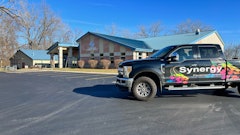






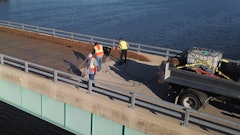




![Screen Shot 2023 01 04 At 5 23 30 Pm[35]](https://img.forconstructionpros.com/files/base/acbm/fcp/image/2023/01/Screen_Shot_2023_01_04_at_5.23.30_PM_35_.63bc42696de27.png?auto=format%2Ccompress&fit=crop&h=135&q=70&w=240)
